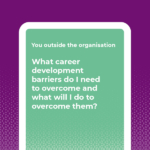And the 19 things HR departments can do to fix it
Are you starting to notice that things aren’t running as smoothly as they should within your organisation? Is your staff attrition rate higher than usual, or are motivation levels low? Are you seeing key demographics leave the business faster than other groups are? It could be that your senior leadership team is at fault.
The impact your C-suite has on your business and its workforce can be huge, and whilst it can be a positive one, it could also be the reason why things aren’t quite right. But how can HR departments tell if their leadership team is contributing to a particular issue? And if so, how can they fix it?
Here’s a bit of help.
In this article, discover the most common mistakes leadership teams can make, their impact on the organisation, and the concrete ways HR departments can help solve the issues.
Lots of mini-mes: when leadership doesn’t promote inclusivity
We’ve all seen it: a board of directors, each of them looking alike. Because of unconscious bias, many leaders tend to hire in their own image and end up with a team of mini-mes. This feels more comfortable to them, but is it really an issue? Yes, it is.
This hiring trend isn’t conducive to innovation, growth, or diversity of opinion, making for an organisation that cannot handle change or adapt quickly.
How can you tell your leadership team isn’t promoting inclusivity?
When leadership teams do not support equality, diversity, and inclusion (ED&I), it can result in certain key groups not feeling psychologically safe and, ultimately, exiting the business. This issue can be unearthed by reviewing recruitment data (such as qualitative feedback from exit interviews or analysis of leavers’ key demographic data).
Don’t forget to include potential candidates dropping off from the recruitment process to the list, as this could also show that the kind of talent you are looking to hire does not feel represented within your company. Look at complaints and grievances, as some of your people may wish to express themselves through more formal channels.
Current employees could also be feeling undervalued or demotivated, or they may believe their progression prospects are limited. “Sometimes it feels like an old boys’ club, so some people may stop going above and beyond seeing as they are unlikely to be rewarded for their efforts,” says Jo Taylor, MD at Let’s Talk Talent.
What HR can do about it
Once you’ve uncovered this issue, make sure you communicate your findings with your leadership team. You can also look for ways to have an impact on ED&I within your organisation, including:
- Reviewing your headhunting strategy.
- Doing a culture audit to understand why some key groups do not feel represented.
- Creating programmes to help certain demographics reach management positions.
- Running unconscious bias training for all senior leadership team members.
- Reviewing pay, promotion and recruitment processes and policies.
- Creating an action group focused on improving ED&I.
- Reviewing your benefits package to see if it is stopping certain people from joining.
- Setting up an anonymous recruitment process by removing the name, education history, and gender of the candidate from the forms sent to hiring managers.
The ivory tower: when leadership doesn’t communicate
Again, this probably sounds all too familiar: the inner sanctum getting together and devising war plans in their secret bunkers, and overall generating a climate of uncertainty for the rest of the organisation.
Some leaders view information as power, and this attitude can affect staff’s wellbeing and create stress, worry, and anxiety, which will in turn affect performance.
How can you tell leadership doesn’t communicate enough?
You’ll notice that motivation and engagement levels are low. The ‘Quiet Quitting’ phenomenon is a good example, with employees no longer willing to do more than what is expected of them. Why is that?
People want to know that they are part of something bigger, and contributing to wider organisational objectives. Performance will therefore be affected as well, which will be reflected in your usual KPIs.
Staff wellbeing is likely to suffer, as their workplace doesn’t feel safe; and their jobs, future, or promotion prospects could be in jeopardy. This can be extremely unsettling, cause stress, and affect mental health.
This is often made worse by the current hybrid reality, and the resulting feeling of disconnection many of us are experiencing.
What HR can do about it
HR should always be at the table when big messages need to be crafted and disseminated. Their role is to hold leadership accountable for communicating with employees in a timely and open manner.
This can be done by:
- Creating concrete communication plans.
- Thinking of all the different channels that can be used to communicate, and investing in different ones (online, face-to-face) to ensure all the bases are covered.
- Gathering employee feedback and finding out where things could be improved.
- Creating work modes that actively encourage communication.
- Focusing on psychological safety. Create an environment where people feel it’s OK to speak up and challenge the status quo.
- Have a change management approach which puts communication at the heart.
Tunnel vision: when leadership doesn’t value career development
Career progression isn’t just about getting the position above you. Unfortunately, many leaders still hold an old-fashioned view of career development and are solely focused on linear, vertical promotions.
This can be extremely limiting for their talent pool, who are likely to leave to explore other development opportunities if none are made available within the organisation.
How can you tell career development opportunities are limited?
Staff attrition rates will be your first clue that career development isn’t valued or developed enough within the business.
Exit interview data and staff feedback from your engagement surveys will also show you that people feel they have limited progression options, and current employees will let their managers know of their frustration at the lack of avenues available.
What HR can do about it
Here, it’s about both creating more opportunities for development and making sure staff is shown a world of possibilities. This can be done by:
- Communicating all possibilities available to staff, from internal mobility to training resources such as coaching & mentoring, or learning materials.
- Training managers, so they can have effective, honest career conversations with their people. Have a look at our Career Sprints to get started.
- Reviewing your internal mobility programme.
- Reviewing your approach to learning and development (L&D). Download the free Let’s Talk Talent’s L&D whitepaper for tips on how to get started building a blended L&D approach.
- Creating the join-up between performance, learning, career progression and succession planning. Make sure all these areas are linked together, and that they are working towards the same purpose: unlocking your staff’s full potential.
Leadership mistakes: command and control doesn’t work
It’s nothing new: the world of work has permanently shifted and the old Parent-Child, top-down approach is out.
Leadership needs to adopt the kind of agile servant leader mentality that will give them the flexibility to fulfil their people’s needs, rather than the other way around.
Easier said than done right! We’ve argued that you can’t train a leader, but you can train a great manager. Managers should be one of your main assets when it comes to creating a positive, psychologically safe internal culture.
“Let leaders lead, but do hold their feet to the fire! And give managers the tools they need to truly make a difference in their people’s employee experience on a daily basis,” says Jo.
If you would like some support, don’t hesitate to have a look at our many leadership performance services and resources, or book a call with us.




